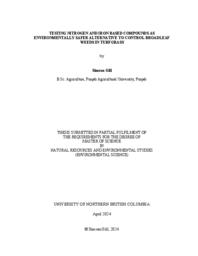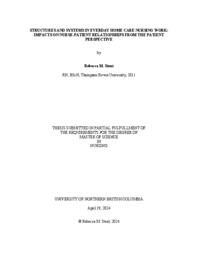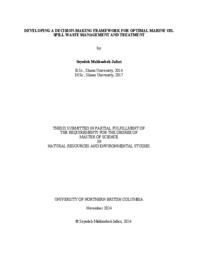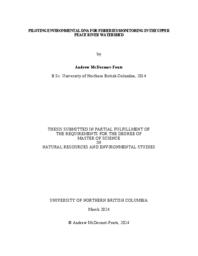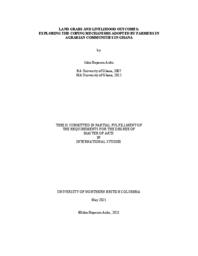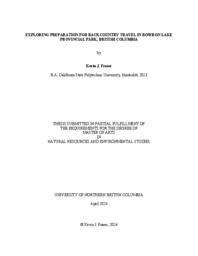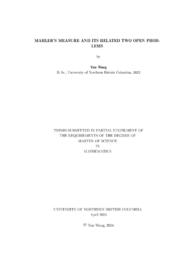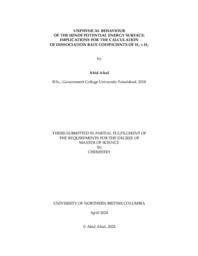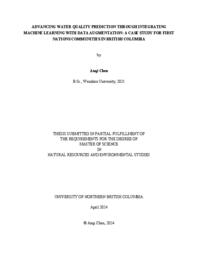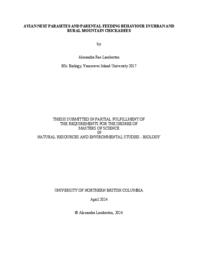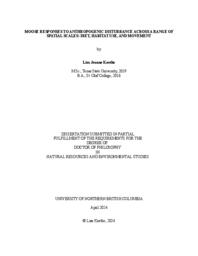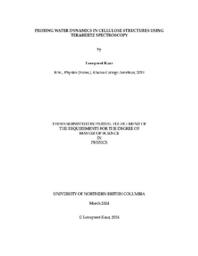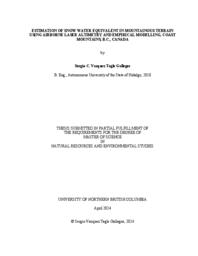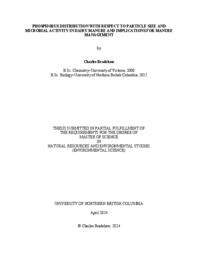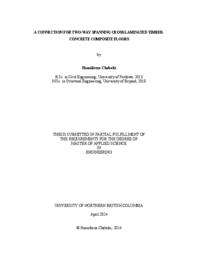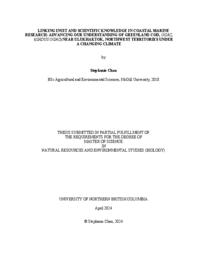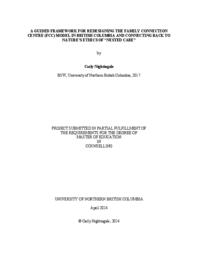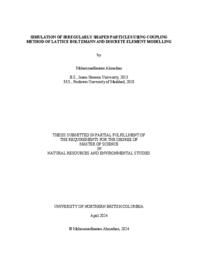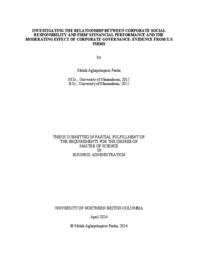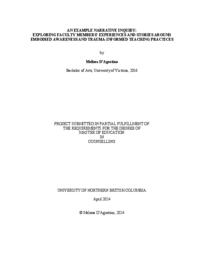University of Northern British Columbia
Related Works
Content type
Digital Document
Origin Information
Content type
Digital Document
Description / Synopsis
Turfgrass is an important component of urban and rural lawns and landscapes. However, broadleaf weeds such as dandelions (Taraxacum officinale Weber ex. F.H. Wigg) and white clovers (Trifolium repens L.) pose major challenges to the health and aesthetics of turfgrass fields. Traditional chemical weed control methods, such as 2,4-dichlorophenoxyacetic acid (2,4-D) herbicides, are commonly used, but their safety and environmental impacts are contentious. Seeking environmentally friendly alternatives, this research investigated the effectiveness of nitrogen and iron compounds as nutrient management methods for weed control. In a two-phase experiment; the first was conducted on a mix of cool season turfgrasses (included perennial ryegrass (Lolium perenne L.), Kentucky bluegrass (Poa pratensis L.) and creeping red fescue (Festuca rubra L.)) grown in plastic containers under controlled conditions in the greenhouse. The treatment application included individual nitrogen (1 = urea and 2 = ammonium sulphate) and iron (3 = chelated iron and 4 = iron sulphate) compounds and their combinations (5 = urea × chelated iron, 6 = urea × iron sulphate, 7 = ammonium sulphate × chelated iron, 8 = ammonium sulphate × iron sulphate) contrasted with 9 = a conventional synthetic herbicide (Killex) and a 10 = control (no application) treatment. Weekly assessments over a 12-week period revealed that the combination of ammonium sulphate × iron sulphate had overall best results for weed control and turfgrass quality indicators, and thus was the most effective in inhibiting the growth of dandelions and white clovers while improving the health of turfgrass. The second part, following the greenhouse studies, tested the efficacy of the ammonium sulphate × iron sulphate treatment versus Killex and a control (no application) treatment under natural open environmental conditions at two sites (site 1: no shade vs. site 2: partial shade) with existing broadleaf weeds. The ammonium sulphate × iron sulphate treatment combination resulted in significant reduction in weed cover (66% and 33% in sites 1 and 2, respectively) as well as yielded superior turfgrass quality (based on visual quality ratings and photosynthetic capacity recorded) as compared to both Killex and the control treatments. Overall, the results of this research demonstrate that the combination of ammonium sulphate × iron sulphate is a promising nutrient management solution capable of achieving both aesthetic goals of weed control and turfgrass quality.
Origin Information
Content type
Digital Document
Description / Synopsis
This thesis examines the institutional structures and systems that coordinate everyday home care nursing work, and how they impact development of nurse-patient relationships from the perspective of patients. Using an institutional ethnographic methodology and incorporating patient-oriented research approaches, I interviewed patients and caregivers to gather rich descriptions of what actually happens in the day-to-day work of receiving home care nursing services, including the work of home care nurses that is visible to patients. Though institutional constraints related to efficiency and productivity can make providing relational care challenging, patients and home care nurses work around these ruling relations and find ways to meet the relational care needs of patients. The often-invisible labour of relational care needs to be recognized and valued at an institutional level to ensure home care nurses can meet the holistic care needs of patients and provide high quality, personalized, patient-centred care within a resource-constrained system.
Origin Information
Content type
Digital Document
Description / Synopsis
This research explores estimating off-shore oily waste, considering waste-waste compatibility due to the heterogeneous nature of oily waste. Firstly, hyperparameters for Artificial Neural Networks (ANN), Support Vector Regression (SVR), and Improved Random Forest (IRF) models are optimized to develop a comprehensive oily waste estimation model incorporating liquid, solid, and total waste types. The results show that IRF is the most accurate model, with the lowest error indices and a higher correlation coefficient compared to ANN and SVR. This study then takes a step further to propose a waste allocation framework, which is tested using information on the Bella Bella oil spill incident in British Columbia. Incorporating treatment and receiving facilities' details, such as their location and capacity, the framework distinguishes all possible waste pathways for handling the waste from source to landfill. Genetic Algorithm (GA) is introduced to optimize waste transfer processes and successfully minimize transportation costs. The results show that the model can find the most optimized path to reduce transportation costs. The model's high customization, adaptability, and capacity to consider multiple nodes make it suitable for complex waste transfer networks, demonstrating its practicality in emergency situations. Efficiently allocating resources and ensuring cost-effective waste transportation while considering facility capacities and waste compatibility, the study holds practical implications for waste management practitioners, environmental authorities, and response teams.
Origin Information
Content type
Digital Document
Description / Synopsis
Applications of environmental DNA (eDNA) represent one of the most significant recent advances in aquatic species monitoring. eDNA has the potential to dramatically increase the effectiveness and efficiency of fisheries monitoring across large geographic areas and particularly for species that have traditionally been difficult to survey. The Williston Reservoir and its surrounding watershed in northern British Columbia is a vast and heavily disturbed aquatic ecosystem where fish stocks have been difficult to monitor with traditional survey techniques. Although eDNA has many potential benefits, the validation process required in a novel environment can be a barrier to adoption. Primer choice and validation, study design and laboratory workflows are critical considerations for eDNA studies and must be evaluated when developing a novel approach in a particular geographic area. My research advanced the validation of species-specific eDNA assays for six prominent pelagic species in the Williston Reservoir and a generic, metabarcoding primer set that was effective in detecting the diversity of fish in the surrounding streams and rivers. The species-specific approach included the validation of four published assays and the development of novel assays for detecting lake trout (Salvelinus namaycush) and peamouth (Mylocheilus caurinus). Lake trout and bull trout (Salvelinus confluentus) are very closely related species that are sympatric throughout much of northwestern North America. The development of a novel lake trout assay that did not cross amplify bull trout eDNA is an important achievement for species-specific eDNA monitoring. Reservoir samples were collected from above and below the thermocline during the summer when the reservoir was stratified to identify species-specific patterns of eDNA distribution throughout the water column. Species detections in the reservoir were comparable for species-specific and metabarcoding assays when compared against gillnet catches in the reservoir. Abundant species that exhibit diel vertical migrations were detected by eDNA and gillnets at all depths. eDNA copy numbers detected were higher for samples with greater abundance and biomass of each species caught in the gillnets. Samples collected from tributaries around the reservoir were tested with metabarcoding primers and species detections were compared to results from a species-specific assay for Arctic grayling and a snorkel survey. Metabarcoding results were comparable to those from the Arctic grayling eDNA study and the snorkels survey, although the metabarcoding methods in this study were less sensitive due to a reduced amount of sample replication. Piloting eDNA in the Williston Reservoir and surrounding watershed has provided valuable insights into eDNA sampling design and the overall workflow for future eDNA studies in the region.
Origin Information
Content type
Digital Document
Description / Synopsis
Large-scale land acquisitions worldwide evoke controversy due to its impact on communities. This thesis employs the Sustainable Livelihoods Framework to examine the coping mechanisms adopted in host communities to cope with the impact of land grabs on livelihoods. The study adopts an exploratory approach using mixed-methods design to arrive at the findings. The thesis finds the effect of land grabbing on communities to be negative. This thesis also finds that the alternative livelihood activities people have resorted to in response are not sustainable. Further, it finds that the regulatory and institutional regime guiding these land transactions has done little to assist the people to cope well with the adverse outcomes of land grabs. These findings point to the need for the establishment of precise timelines for compensation to affected people. Also, there is the need to involve the people in the decision-making process from project planning to implementation.
Origin Information
Content type
Digital Document
Description / Synopsis
Outdoor recreation trips have long been conceptualized as relatively linear multiplephased experiences. Previous studies of recreational activities and visitor experiences in backcountry settings have largely focused on the onsite phase. This study, however, explored the nature and elements of preparation and its influence on the backcountry experiences and meanings, as recollected by participants. Secondarily, this project aimed to better understand the roles of technology in preparation. The study used semi-structured interviews with participants who had completed one or more canoe or kayak trips in Bowron Lake Provincial Park in British Columbia, a world-renowned backcountry canoe circuit. Findings indicate that preparation is an ongoing process comprised of multiple elements by which participants are involved throughout all phases of an outdoor experience. Preparation can help improve safety and satisfaction during backcountry experiences and has important implications for recreation and leisure programs and practices, parks and protected areas management, and outdoor education. Conceptually, the research suggests that preparation is not as linear or time-bound as the five-phase model would suggest. Rather, aspects are ongoing throughout and between trips, accrued with mentorship and training over the course of a career, and involve elements of tasks and efforts beyond simply ‘planning’ trip logistics.
Origin Information
Content type
Digital Document
Description / Synopsis
This comprehensive study delves into the intricate connections between economic and financial factors and carbon dioxide (CO2) emissions across G20 nations (excluding the European Union) spanning 1994 to 2021. our investigation, utilizing a multiple linear regression model, meticulously examines diverse energy consumption types, financial institutions, life insurance premiums, economic factors, and the aftermath of the 2008 financial crisis. Our preliminary findings reveal robust links between various energy sources, financial institutions, life insurance volumes, and CO2 emissions. Notably, the Financial Institutions Index and Life Insurance Premium Volume unveil novel insights that can add new visions to conventional perspectives. Recognizing the influential role of the G20 on a global scale, our research aspires to inform and guide sustainable policy decisions. Methodologically, after a comparative evaluation of various data transformation methods, we employ a cube root transformation to enhance analytical precision. Also, Principal Component Analysis (PCA) reveals underlying patterns in the data. Granger causality tests shed light on temporal relationships, complementing the robust quantification of each variable's impact on CO2 emissions derived from the linear regression model. Rigorous validation, including Durbin-Watson, Breusch-Pagan, Shapiro-Wilk, RESET, Bonferroni Outlier test, and ADF stationarity tests, ensures the reliability of our results. Our linear model enhances interpretability and provides clear insights into the determinants of CO2 emissions. This research significantly contributes to the field by extending our knowledge of the complex factors influencing CO2 emissions. It unveils unexpected relationships, underscores the pivotal role of financial institutions, explores the repercussions of economic crises, and provides practical policy implications. Methodologically, our study stands out for its advanced statistical analyses. This research yields a valuable understanding of the sustainability framework, presenting a nuanced view for policymakers, researchers, and practitioners alike. This study enhances the academic speech by thoroughly addressing the factors influencing CO2 emissions and delivering a foundation for informed decisionmaking in pursuing a more sustainable future.
Origin Information
Content type
Digital Document
Description / Synopsis
The main achievement of the thesis is the proof that 1+√17 is not a Mahler measure of an algebraic number. This answers a question of A. Schinzel posted in [6] in 2004. We also show that, theoretically, there exists an algorithm to reduce the shortness of a polynomial without changing its Mahler measure, a problem considered in [5] by J. McKee and C. Smyth. However the number of computations required makes this algorithm infeasible.
Origin Information
Content type
Digital Document
Description / Synopsis
Molecular hydrogen is the dominant molecular species present in the interstellar medium and has an important role in the cooling of shocks that are associated with star formation. The two mechanisms of cooling are collisional excitation followed by quadrupole emission and collisional dissociation. Modelling the role of dissociation in this cooling needs detailed information on the state specific dissociation rate coefficients. The initial goal of this research was to compare the trajectory outcomes on the Hinde potential energy surface (PES) with those on the BMKP2 PES to assess whether it is required to do extensive and more expensive calculations to determine state specific rate coefficients for dissociation of H2 + H2 to supersede those previously determined with the BMKP2 surface. A phenomenon of double dissociation was unexpectedly identified within the Hinde PES, despite the absence of sufficient energy for such an occurrence. These results prompted a comprehensive analysis of the Hinde PES, which in turn involved an exploration of the regions that exhibit unphysical behavior. This detailed examination unveiled problematic aspects of the potential energy surface. As a result of this, it has been determined that the Hinde PES is unsuitable for calculating dissociation rate coefficients for H2 + H2.
Origin Information
Content type
Digital Document
Description / Synopsis
Clean drinking water access is essential for public health and regarded as a scarce resource for Indigenous communities in rural and remote areas. In this research, a new iron and manganese prediction method based on Data Augmentation and Machine Learning Algorithms to be applied to drinking water in BC’s First Nation communities is reported. GAN based modelling and NIBS-NI based modelling were developed to investigate the effects of different data augmentation methods and predictors for iron and manganese prediction results. Reliable synthetic data was obtained through both data augmentation methods, allowing 4 machine learning algorithms to predict iron and manganese utilizing 3 and 5 physical properties respectively. Compared with RF, XGB, and DT machine learning models, the GBR model showed the strongest fitting ability and accurate predictions for both NI-BS-NI based modelling and GAN based modelling in predicting iron and manganese, with the Train R2 and Test R2 of two models nearing 1, and all the RMSE scores are below 0.06. The decision-making tool developed using GAN technology is considered to have greater application potential due to its ability to provide accurate predictions while requiring only 3 input physical parameters.
Origin Information
Content type
Digital Document
Description / Synopsis
Urbanization is considered one of the greatest human-caused threats to biodiversity. Human development and encroachment on native habitats and its impacts on species, however, is nuanced; while it has been found to create detrimental impacts on some species, certain aspects of urbanization may benefit others. This interaction of advantages vs constraints offered by urban landscapes is especially relevant to species that show sufficient behavioural plasticity to settle in this rural/urban interface. The objective of this thesis is to investigate some of these potential costs/benefits of urbanization in mountain chickadees. I first assess a potential positive effect of urban settlement noted in other systems – a decrease in the incidence of nest ecotparasites found in urban landscapes - in mountain chickadees nesting in Kamloops, BC, Canada. I enumerated the blowflies and fleas found in collected nests in 2019 and 2020 to determine whether nest parasitism differs between urban and rural habitats in the region, and whether this in turn influences nest success (Chapter 2). I found that abundance of blow fly puparia was higher in rural nests, but that flea abundance was associated with temperature and not urbanization. Additionally, I observed that urban nests fledged approximately one additional chick per nest. This suggests urban habitats could lift some constraints that would normally decrease nestling condition. I then compared rates of adult chickadees feeding nestlings to determine whether differences in ectoparasitism levels between habitats results in compensatory feeding by parents, and if this affected the growth rate of nestlings (Chapter 3). I did not find evidence that urbanization or ectoparasite abundance influenced parental feeding or growth rate. I did find that feeding rate was lower and that growth rate was higher in warmer years. Other studies showing potential differences in prey availability between habitats, with rural sites having potentially greater abundance of prey, may help explain my results – while prey might be more abundant in one habitat, nestling condition may be less affected by parasite infestation in the other, helping balance the costs/benefits of settlement between habitats. While my results provide some evidence that reduction of parasites in urban areas can benefit urban settling species, further research will be required to determine the mechanism that causes this phenomenon.
Origin Information
Content type
Digital Document
Description / Synopsis
Archaeological Predictive modelling is a tool that predicts the location of archaeological sites and materials in a region, based on the observed pattern in a sample data or on assumptions about human behavior. This project examines the combination of variables to produce a model with high predictability and the application of inductive predictive modelling method in locating areas of high archaeological potential in Prince George using Binary Logistic Regression. Results from the analysis have shown that terrain variables: slope, ruggedness, elevation, solar incidence and proximity to water, jointly explains the predictive model and that the model successfully predicts areas of high and low potentials in Prince George municipal. The results from the Kvamme’s gain statistic shows that the predictive model is moderately efficient. The study recommends that by incorporating more terrain variables, the model performance will be higher and probably be more efficient.
Origin Information
Content type
Digital Document
Description / Synopsis
Habitat loss and climate change are two of the leading causes of the global decline of biodiversity. Declines in the abundance of moose (Alces americanus) in British Columbia, Canada, in the 2000s were hypothesized to result from an interaction between a severe climate-induced insect outbreak and resulting increases in salvage harvest of affected forests. I investigated the behavioral and distributional responses of moose to forest harvesting disturbance across a range of spatial scales and tested the use of N-mixture models and camera trap data to estimate population abundance. At a fine spatial scale, I used microhistological analysis of moose fecal samples to assess the effects of logging on the diet of moose. In areas with greater intensities of forest harvesting, moose consumed fewer forbs, shrubs, and fir trees, and their diet was more diverse. These dietary responses were consistent with the Niche Expansion Hypothesis, which predicted that a generalist herbivore would eat a greater diversity of plants to compensate for decreased availability or quality of preferred forage. I used LiDAR and GPScollar data to test hypotheses that explained the use of horizontal and vertical cover by moose. Risk of predation and hunting (Direct Mortality Hypothesis) was the primary factor that influenced the use of cover. Moose used different forest structures, ranging from open to closed, depending on the threat (predation or hunting) and their response was modulated by maternal status. At a coarser spatial scale, I assessed a suite of hypotheses concerning the causes of partial migration, effects of migration on habitat used, and fitness effects of migration. Wildfire disturbance in the winter range was the primary driver of migration and most migratory moose experienced less wildfire disturbance after leaving their winter range. Migrants displaying specific movement tactics (e.g., distance and timing of migratory movements) experienced increased probability of parturition and neonate survival. Migration exposed moose to increased risk of predation but residents were more vulnerable to health-related causes of mortality. While migration provided some moose with fitness benefits, it did not fully mitigate the amount of wildfire disturbance in the summer range, particularly after severe wildfire seasons. Finally, I tested the sensitivity of estimates of population abundance produced by N-mixture models parameterized with camera trap data to ecological conditions, spatial scale of covariates, the potential for temporally non-independent detections, and model choice based on parsimony. Nmixture models produced accurate and reasonably precise estimates of abundance of moose and were robust to model formulation, the spatial scale of associated covariates, and the criteria used to define independent detection. However, I recommend avoiding measures of parsimony for selecting the model or models to generate a population estimate. In total, the results of my dissertation suggest that land management and forest harvest should maintain forest communities that vary in structure and composition. In particular, large-scale disturbance can alter the diet of moose, expose maternal moose to increased risk of mortality, and, in the case of wildfire, it could lead to a decline in migratory behaviors and populations.
Origin Information
Content type
Digital Document
Description / Synopsis
Terahertz time-domain spectroscopy was used to probe water dynamics in microcrystalline cellulose. In this study, the variation of the dielectric constant of water in microcrystalline cellulose samples with moisture contents between 2.65% and 16.73% was studied. It was found that the dielectric function of water does change with a change in moisture content in microcrystalline cellulose. The dielectric function of water appears to change from what might be expected for bound water towards values that are more consistent with bulk water at higher moisture content. This study is a step forward in the direction of understanding if the dielectric function of water goes from bound to free with a change in moisture content in microcrystalline cellulose. Future work to understand the detailed behavior of this transition is important for wood science and THz application to wood science.
Origin Information
Content type
Digital Document
Description / Synopsis
This research aims to enhance scholarly understanding of snow dynamics, the remotely sensed snowpacks, and the calculation of basin-wide snow water equivalent in mountainous terrain. Mountain snow is a critical source of meltwater. However, forecasting snow distributions and total water equivalence in mountain basins is limited due to complex terrain, challenging environmental conditions, and lack of observations. Laser altimetry can provide detailed observations of snow depth, but an estimate of snow density is required to evaluate the total basin water equivalence. This study uses laser altimetry surveys and empirically modelled snow densities to estimate mountainous basin-wide snow-water equivalent (SWE). Between 2017 and 2020, seven laser altimeter surveys during late winter and spring were conducted in the LaJoie Basin, Coast Mountains, British Columbia (B.C.), a strategic hydroelectric power reservoir. The laser-derived snow depths averaged between 1.4 and 2.1 m for non-glacierized terrain, while glacierized terrain weighted averages ranged between 2.2 and 5.4 m. The laser-derived depths were combined with empirical snow density models to derive distributed SWE for the Lajoie Basin. Ten linear and three non-linear snow density empirical models were tested and developed, from which (a) a snow course multi-parameter, non-linear relation and (b) snow pillow robust (Huber loss) linear regressions yielded this study’s lowest root mean squared errors (51.65 and 74.12 kg m-3, respectively). For non-glacierized terrain, the multi-parameter, non-linear model produced basin-wide SWE averages between 0.56 and 1.06 m.w.e. and propagated uncertainties from ± 0.1 to ± 0.14 m.w.e. Conversely, glacierized terrain exhibited weighted SWE averages between 0.82 and 2.93 m.w.e., with estimates of uncertainty ranging from ± 0.31 to ± 0.52 m.w.e. The robust linear regressions yielded non-glacierized SWE averages from 0.49 to 0.92 m.w.e., with uncertainties between ± 0.14 and ± 0.2 m.w.e. The weighted SWE averages in glacierized terrain ranged between 0.77 and 1.92 m.w.e., with estimates of uncertainty between ± 0.29 and ± 0.45 m.w.e. The SWE estimates from lidar and modelled density are comparable to snow pillow observations at the watershed, which demonstrates the effectiveness of these coupled techniques and improves our forecasting capabilities.
Origin Information
Content type
Digital Document
Description / Synopsis
The Marshmallow Effect is a fictional work that explores the consequences of isolation and trauma on an individual’s identity. The story revolves around the protagonist Arthur, a man who inadvertently creates a reality-bending psychological safe haven to protect himself from his past only to have it warp and transform into an insidious space which forces him to confront said past. This project, written as a screenplay, follows Arthur as he experiences and is affected by horrifically warped versions of his memories, unbound by the rules of reality and fantastical in their proportions, until he becomes an active participant and takes back control of his space and identity. Through discussions of horror, ghosts, folklore, film, and psychological critique, my introduction breaks down the application of setting in the story as a transformative, trauma-informed space that is inexorably intertwined with Arthur’s identity and body, the relationship between the characters and repetition of action to initially reinforce, then defamiliarize, identity, and the difficulties in confronting or coming to terms with trauma in order to move past negativity and into a realm of greater stability in terms of the self and identity.
Origin Information
Content type
Digital Document
Description / Synopsis
This work investigated the distribution of phosphorus in dairy manure as it relates to particle size and provides experimentally derived insights for improving the management of phosphorus. The data presented here illustrates some aspects of manure handling that may be optimized for controlling the distribution of phosphorus. It provides experimental data that supplements existing literature by 1) extending the limits of study regarding particle size distribution; 2) extending the limit of centrifugal forces studied; 3) demonstrating an improved pathway for phosphorus management in wastewater using a substrate mediated flocculation process; and 4) providing some experimental observations showing that the microbiota present in dairy manure can diminish stratification of suspended solids and phosphorus concentrations within separated liquid manure products. Further, based on quadratic modeling of phosphorus relative to sieve size, and the observations that accompanied progressive washing and mechanical agitation performed, a convincing argument for relating phosphorus distribution to the surface area of a substrate is made. The findings imply that much of the phosphorus present in manure is superficially bound to larger particulates, rather than an intrinsic or chemical part of the bulk material itself, and can be mediated by washing or mechanical means where the phosphorus present in coarser fractions can be shunted towards finer or liquid fractions. Approximately 80% of phosphorus was associated with particulates bound to larger substrate. Indeed, 95.5% of the phosphorus in the bulk manure was removable as particulates with cross sectional diameter less than 2mm by simple washing. Further removal of phosphorus in >2mm substrate through fermentation and leaching was also demonstrated. Some portion of this distribution in phosphorus appears to be dominated by microbes.
Origin Information
Content type
Digital Document
Description / Synopsis
Child protection workers are responsible for making complex decisions to protect children from abuse and neglect. Child protection workers receive specialized training on how to make unbiased decisions based on evidence. Yet, external factors can influence the decision-making process. Method: A qualitative study using interpretative description was deployed and eight former child protection workers in northern British Columbia were interviewed. Semi-structured interviews were conducted with an emphasis on the external factors that may influence child protection workers’ decision to remove a child from a legal guardian. Results: Three main themes with 10 subthemes emerged from the data. The first overarching theme was pressure (workload, appearance, politics, and policies). The second overarching theme was hierarchy (management, team leader, team members, and experience). The final overarching theme was resources (support services and placements). The former child protection workers established and clarified external factors that may influence their decision-making process. Conclusions: Several external factors that influenced decision making in relation to the removal of a child from a legal guardian were identified. These findings may help inform professional training for future child protection workers.
Origin Information
Content type
Digital Document
Description / Synopsis
Cross-laminated timber (CLT)-concrete composite (CLTCC) floors have gained popularity in recent years due to their advantages over pure wood floors. They offer a high loadcarrying capacity, increased stiffness, improved fire resistance, vibration performance, sound insulation, and thermal mass, making them suitable for floor applications with long spans and twoway spans. However, to fully utilize the two-way spanning capacity of CLTCC floors, the minor strength axis panel-to-panel edge connections need to withstand out-of-plane bending for composite action. In this study, experimental and numerical investigations were conducted to investigate the use of steel kerf plates (K connection) and steel T-bars (T connection) as edge moment and shear connectors in CLTCC floors. The kerf plates were embedded in 139-mm-thick five-layer CLT panels to a depth of 35 mm, and T-bars were mounted with self-tapping screws to connect two CLT panels of 600 mm length from the top and LVL spline from the bottom. T-bars were connected to CLT by screws in the shear zone as shear connectors. A total of 30 test specimens were subjected to shear forces and bending moments to evaluate load-carrying capacity, rotational and bending stiffness. In the shear tests, the T connection exhibited a shear connection stiffness approximately twice that of the K connection in the minor direction, with a 46% greater load-carrying capacity. The T connection in both directions could provide the two-way composite action required in the CLTCC slab. However, the T connection serviceability stiffness in the minor direction was approximately 40% lower than that in the major direction. The bending tests demonstrated that the combination of T connection and LVL spline effectively reached the rotational and bending stiffness, as well as the loadcarrying capacity, of a continuous CLT panel with the same layup. While T and K connections achieved similar load-carrying capacity, the bending stiffness with the K connection was only half of that with the T connection. In addition, the rotational stiffness with the T connection was approximately 1.6 times greater than that of the K connection. The composite efficiency was 56% for the T connection and 7% for the K connection, demonstrating that the T connection provides composite behavior in the minor strength axis. In the numerical investigation, a sensitivity analysis was conducted to assess the factors impacting the bending capacity and deformations of CLT and CLTCC slabs interconnected by T connections including biaxial connection stiffnesses between two layers and rotational stiffness between two panels. Subsequently, a 9×12 m CLTCC slab with T connections was designed and modeled. The two-way action was predominantly influenced by the connection stiffness and rotational stiffness in the minor axis, and the proposed connection demonstrated adequate stiffness in facilitating the transfer of moment and shear forces between panels and layers.
Origin Information
Content type
Digital Document
Description / Synopsis
The Arctic is warming at an unprecedented rate, with implications for the marine ecosystem and species that are important for the tradition, culture, and livelihoods of Indigenous people. Inuit in the western Canadian Arctic have identified a need to better understand the impacts of a changing climate on coastal marine species important for subsistence. Greenland cod, ogac, (Gadus ogac) are found in the coastal marine ecosystem and are reportedly experiencing changes in population dynamics in recent years. In this thesis, I present findings from Inuit and scientific knowledge of Greenland cod as a means of linking knowledge systems to advance our understanding of this species and discuss the implications for Inuit livelihoods under a changing environment. The objectives of this research were to: (1) investigate the adaptation potential of Greenland cod, (2) document Inuit knowledge of this species, and (3) examine the cumulative findings of Greenland cod research and discuss the potential impacts of shifting marine resources on livelihoods in the Inuvialuit Settlement Region. I measured individual specialization-generalization of morphological and habitat-trophic traits from Greenland cod collected along the marine coast near Ulukhaktok, Northwest Territories, NT, in the western Canadian Arctic. I then used this information to elicit discussion on their morphology, feeding, and movement behaviour with key knowledge holders in Ulukhaktok. Scientific findings from this project suggest that Greenland cod are overall generalists but display a range in feeding behaviours for two identified morphotypes. These findings highlight the importance of maintaining trait variation to conserve biodiversity while promoting population resilience in wild fish populations. Inuit knowledge holders were able to build a rationale for some of the phenomena observed and identify early signs of ecosystem change. Linking Inuit and scientific knowledge was a two-way process in which the knowledge systems built off one another to inform the next steps in the research process and interpret the findings more holistically. The cumulative findings advance our understanding of the baseline ecology of this species and intend to inform the design of future research using Inuit and scientific knowledge to generate enriched findings. The knowledge gained and lessons learned from this study can serve as a tool for establishing additional conservation efforts that may be required in the future to ensure a sustained Arctic marine ecosystem can continue to support Inuit subsistence and livelihoods.
Origin Information
Content type
Digital Document
Description / Synopsis
In October 2021, the Ministry of Children and Family Development (MCFD) announced a new centralized hub model in British Columbia branded as Family Connection Centres (FCCs) that would replace and eliminate the Autism Funding Program by the Spring of 2025. While the intentions of FCCs are to create a new model of care that is designed to support children and youth from birth up to nineteen years of age with developmental challenges and create easier access and navigation of services for families and caregivers, it has not come without its share of significant concerns from professionals and communities across BC. The intent of this research project is to provide a guided framework to address the concerns that have been raised and include important recommendations from Foundry, a well-established youth agency in BC, as well as incorporating essential ethics from nature that will help to design a better agency structure and model. The proposed framework will focus on building from existing services and unique family networks, as well as connecting back to land and nature, to support and raise healthy children and create strong, connected familial communities.
Origin Information
Content type
Digital Document
Description / Synopsis
In this study, the lattice Boltzmann method (LBM) and the discrete element method (DEM) are coupled to simulate the interaction between the fluid phase and irregularly shaped solid particles. For this purpose, the geometry of real particle shapes is represented as clumps of overlapping spheres and then simulated through a multi-sphere model in DEM and coupled with LBM using two open-access codes, LIGGGHTS and Palabos. The accuracy of the coupling method with clumps is demonstrated by simulating several benchmark cases and comparing them with the results from the literature. The coupled LBM-DEM method is then used to simulate the collapse and transport of submerged granular particles with four different irregular particle shapes in addition to sphere particle shapes to highlight the influence of grain morphology in the solidfluid interaction. To the authors’ best knowledge, it is the first time that LIGGGHTS and Palabos were used to simulate the LBM-DEM coupling of irregular particles. This study demonstrates the potential and accuracy of LBM-DEM method in simulating particles with irregular shapes. The research also provides insight into the importance of considering real shape particles in simulating granular flows in geotechnical engineering.
Origin Information
Content type
Digital Document
Description / Synopsis
Many studies have examined the relationship between corporate social responsibility (CSR) and a firm’s financial performance. These investigations have had mixed results. Some studies find a positive relationship, others find a negative relationship, and yet some studies find no significant relationship. This ambiguity highlights the complexity of the relationship between CSR initiatives and firm performance. The present study attempts to better understand this relationship. As such, it has two objectives. Since most of the previous studies have examined a linear relationship between CSR and a company's financial performance, the first objective of this study is to investigate whether there is any nonlinear relationship between CSR and firm’s financial performance. The second objective of this study is to examine the moderating effects of corporate governance factors, especially the board of directors’ characteristics such as board size, board independence, board gender diversity, and CEO duality on the relationship between CSR and a firm’s financial performance. The latter factors have not been fully considered in previous studies as the focus has been on the direct link between CSR and the firm’s financial performance. The study uses panel data from a sample of 82 firms from a large group of publicly traded American firms, which are listed on the U.S. stock exchange and are part of the S&P 500 index covering the years 2012-2021, and a nonlinear panel regression model to estimate the relationship between firm’s financial performance as measured by Return on Asset (ROA) and CSR disclosure index along with a control variable and four Corporate Governance indicators and their interactions with CSR disclosure index. The study finds a non-linear positive relationship between firm’s performance and CSR, suggesting a declining effect of CSR on firm’s performance at higher levels of CSR. It also finds that board gender diversity positively affects the relationship between CSR and a firm’s financial performance. We find no statistically significant interactions between CSR and the Governance indicators of board size, board independence and CEO duality.
Origin Information
Content type
Digital Document
Description / Synopsis
no abstract available
Origin Information


